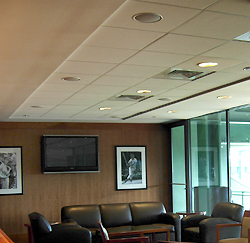Part one in this series is available here.
We need to consider the real, long-term sound pressure level capability of today’s sound reinforcement systems to make sure they’re not being operated at levels where the components are stressed or where they won’t sound good.
While acoustic design programs do a good job of predicting how the system will perform in a given room, the system designer must determine what the goal is for each application.
What SPL Is Not
SPL is not a substitute for fidelity! Have you ever been to one of those locations where management seems to think it is meeting today’s need for higher quality music simply by putting in a louder sound system? Either your thoughts get drowned out in the barrage of noise, or the loudspeakers sound awful because they’re turned up beyond their capacity.
SPL alone cannot make up for lack of fidelity. We need to consider the real, long-term SPL capability of today’s systems.
Maximum SPL Capability. In the simplest theoretical terms, loudspeakers produce sound levels according to three factors:
1) the loudspeaker’s power handling capability (specified as driven with an industry-standard pink noise signal)
2) the loudspeaker’s sensitivity (the sound level produced with 1 watt of input power)
3) the distance between the loudspeakers and the listening plane
Power handling and sensitivity are generally provided on the loudspeaker’s spec sheet. (Note that JBL Pro includes a 2-hour and a 100-hour power spec on some loudspeakers. The 100-hour figure is for reliability testing. The 2-hour is the figure to use for these SPL computations.)
Consider the distance from the loudspeakers to be the ceiling height minus the listening-plane height (sometimes called ear height). It’s common to assume that ear height for a seated audience is around 3.5 feet above the floor, and ear height for a standing audience is about 5 feet above the floor, on average. For every doubling of distance beyond 1 meter, subtract 6 dB.
Maximum SPL Formula for Pink Noise. The formula for computing maximum SPL capability for a pink noise signal is:
M(“pink”) = S + 10(log P ) – 20(log D )
—where M(“pink”) is maximum average SPL for pink noise, S is SPL from sensitivity, P is pink noise power handling and D is distance in meters.
The SPL Adjustment for Music and Speech. This resulting SPL for pink noise figure, even at the standard 1-meter distance, is not a measure of the typical music or speech that can be expected from the system.
Pink noise is different from music and speech. A downward adjustment of at least 4 dB must be made to the maximum pink noise computation to reflect the maximum average SPL capability for music or speech.
Why does a 4 dB adjustment need to be made? Pink noise has a peak-to-average ratio of 6 dB. In other words, the average signal is only 6 dB lower than the peak signal.
Music or speech, on the other hand, has a peak-to-average ratio of at least 10 dB. If we keep the peak capability at the same point as where it has been tested with the pink noise, then average music or speech is 10 dB below that (or 4 dB below the pink noise’s average level). Take the pink noise rating and lower it by at least 4 dB to get the maximum SPL capability for music or speech. Voila!
Notice that this adjustment factor is based on an assumed 10 dB peak-to-average ratio. I use 4 dB as the highest average music or speech will be able to attain. You may choose to make an even bigger adjustment, maybe -6 dB or -10 dB, corresponding to peak-to-average ratios of 12 dB or 16 dB.
Adjusting our formula, the maximum SPL of music or speech of a single loudspeaker is:
M(“music or speech”) = S + 10(logP ) – 20(logD ) – 4
—where M(“music or speech”) is maximum average SPL for music and speech, S is SPL from sensitivity, P is pink noise power handling and D is distance in meters.
SPL Capability of Multiple vs. Single Loudspeakers. One other thing to consider is that the SPL capability of a multi-loudspeaker system is higher than that of a single loudspeaker because multiple loudspeakers overlap to a degree that depends on their layout and spacing.
SPL of 70V/100V vs. Low-Impedance. Loudspeakers with 70/100 volts produce lower output SPL than do low impedance (4-, 8- or 16-ohm) loudspeakers. This is because, first, 70/100-volt loudspeakers are typically tapped at lower power levels than the low-impedance loudspeaker’s maximum capabilities. Second, there is always some insertion loss through the loudspeaker transformer.
Possibly the biggest factor, though frequently overlooked, is that the driving amplifiers clip at 70 volts (on a sine wave). The highest the audio signal can get before clipping is 70 volts (or 100 volts outside the United States). The average for music or speech is at least 10 dB below that. So, if you’re tapped at 15 watts, you’re really only averaging somewhere around 1.5 watts of sound out of that loudspeaker, and that’s with the peaks hitting clipping!
If you compute SPL based on the mistaken assumption that you get a continual 70 volts going into the loudspeaker, your estimate is going to be at least 10 dB higher than the real average music or speech that can actually come out of that loudspeaker!















